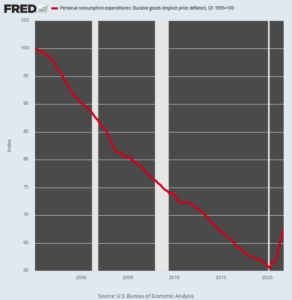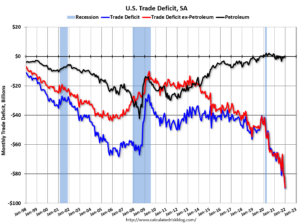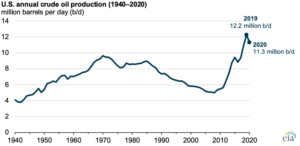
Goodness me, even the Wall Street Journal is capturing on. In a piece about the inflationary rebound theory of a former UK central lender named Charles Goodhart, it in fact tees-up the possibility of high inflation for a decade or longer due to an unfavorable, epochal shift in the global labor supply.
He argued that the low inflation given that the 1990s wasn’t so much the outcome of astute central-bank policies, however rather the addition of numerous countless economical Chinese and Eastern European workers to the globalized economy, a group dividend that pushed down salaries and the costs of items they exported to rich countries. Together with brand-new female workers and the big baby-boomer generation, the labor force providing advanced economies more than doubled between 1991 and 2018.
He got that right. Now, nevertheless, the working-age population has actually begun shrinking for the very first time given that World War II in developed economies, intensified by an ever more generous banquet of Welfare State complimentary things that is diminishing the offered labor force even further. At the very same time, China’s working force is anticipated to contract by a staggering 20% over the next three decades.
Needless to say, as worldwide labor ends up being more limited, developed world workers will lastly have bargaining take advantage of to push up their own formerly stagnant salaries. In the United States leisure and hospitality sector, for example, where worker lacks are most intense, Y/Y wage gains have averaged 15% for the last 3 months running.
And that’s not a “base impact”, either. On a two-year stacked basis, the gain from the February 2020 pre-Covid peak was 7.3% per year. That’s nearly triple the average yearly gain during much of the last decade.
Y/Y Modification In Hourly Profits of Leisure And Hospitality Employees, 2012-2022

But on the margin it is the draining pipes of China’s rice paddies of subsistence labor that is sustaining the now unfolding epochal change in the international labor expense curve and supply chains. As China’s labor force continues to diminish and less rural workers have actually transferred to cities, its domestic labor costs have predictability risen.
U.S. production salaries, in truth, are now less than four times as much as those in China, compared to more than 26 times when China signed up with the WTO in 2001, according to recent research by investment firm KKR. And that’s simply the warm-up: China’s labor force is anticipated to shrink by about 100 million over the next 15 years– an economic pile-driver that will trigger the deflationary “China Price” of the past three years to morph into the inflationary “China Rate” in the years ahead.
Furthermore, this was all already well in progress owing to the natural, baked-in demographics of the global labor market. And now that Washington has jumped the shark with its wild Sanctions War versus the global trading and payments system, the shift is likely to be dramatically worsened.
That is to say, the 26:1 labor expense benefit China had in the early 21st century when the supply chain was globalizing at break-neck speed was even then off-set in part by all the non-labor aspects that go into worldwide sourcing of goods. These include transport expenses, insurance coverage costs, extended inventory pipelines, quality control, product delivery and accessibility dangers, periodic premium costs for expedited shipping and far more. Yet on balance the former well outweighed the latter, triggering delivered item costs to methodically fall.
As we have regularly pointed out, the proof of the pudding remains in the PCE deflator for durable goods, which got massively off-shored into the low-priced nooks and crannies of the worldwide supply chain throughout the “inflation sabbatical” of 1995-2019. As it took place, the index came by a shocking 40% throughout that period– a one-time deflationary plunge that has no precedent in economic history.
PCE Deflator For Resilient Item, 1995-2022

Now, however, the prospective advantage of all these non-labor supply chain costs and dangers have actually increased drastically. In a word, worldwide supply chains are going to get reeled-in and reduced drastically because in many circumstances the labor differential will no longer successfully offset these associated expenses.
Mentioned in a different way, the “lowflation” canard was always an analytical mirage, however under the double-whammy of increasing global labor expenses and skyrocketing supply chain expense, there will now be no doubt. Significant, persistent inflation in the expense of products will end up being the order of the day, leaving the simple cash main bankers of the world no choice except to finally shutdown their printing presses.
Needless to say, this will leave the permabulls of Wall Street in a world of hurt and for many years to come. That’s since the corollary of the now ending Inflation Sabbatical of 1995-2019 was the enormous off-shoring of America’s productive economy, tracked by the relentlessly plunging deficit on items and services.
The current release of the January 2022 trade balance leaves little to the creativity, taping a record deficit of $89.7 billion for that month alone. Moreover, this figure consists of credit for the $19.2 billion surplus on services, suggesting that the actual deficit in merchandise goods taken independently was almost $109 billion. That’s an annualized run rate of $1.3 trillion!
Of course, when international goods rates climb gradually higher under the abovementioned double-whammy of increasing labor expenses and de-globalization of supply chains this massive exposure to imports will whoosh through the United States economy like green grass through the proverbial goose. As it does, our unaware Keynesian main bankers will be proverbial too, as remains in deer in the headlights.
That is to state, what we have is an economic boomerang. When the supply chain was heading out to the least expensive corners of the worldwide labor market, deflationary forces came receding. However the inverse is now occurring: Supply chains are reeling back in toward the domestic cost structure, suggesting that inflation will come ripping back, also.
US Trade Deficit On Goods And Services, 1990-2022

Really, however, the true image is more alarming than recommended by the chart above. That’s due to the fact that the non-petroleum share of the trade deficit has actually swollen a lot more egregiously throughout the last three years than the overall figure.
As shown by the red line in the chart below, the ex-petroleum trade deficit was just $8 billion per month in 1998 and now stands at nearly $90 billion each month owing to the truth that the fracking transformation has minimized the petroleum deficit (black line) to zero. This means that the inflationary whirlwind bearing down on the merchandise products accounts will be even more virulent.

And while we are on the subject of energy trade and so-called energy independence, now might be as excellent a time as any to remedy that shrill Fox News drumbeat that the Donald got America energy independent and after that Sleepy Joe blew it in less than a year.
The reality is, presidents do not identify the output level or the trade balance for any sector of the United States economy– the forces of supply, demand and investment/disinvestment rewards do. The peak level of domestic petroleum production reached in February 2020 of 13.1 million barrels per day, therefore, was an effect of the international petroleum rate and investment cycle, not the Donald’s arm-waving, consisting of the tried revival of the Keystone Pipeline.
The latter was merely a more affordable way than rail to get Canadian tar sands to the refinery markets on the US gulf coast; it would have indicated higher netbacks (rates received after transportation and other delivery expenses) to Canadian oil sands producers, not more production or lower costs for American customers.
Similarly, the Donald’s more sensible public lands leasing policies were plainly remarkable to those of Obama, but given the long lead-time between lease awards on public lands and actual brand-new production, the impact was irrelevant in the time frame under discussion.
So what happened is what usually takes place: The domestic petroleum production cycle had precisely nothing to do with four-year governmental terms. On that matter, the history is dispositive.
For instance, during the freeze-in-your-cardigan-sweater term of Jimmy Carter, domestic oil production rose from 8.1 million barrel daily in January 1977 to 8.6 million b/d in January 1981, a gain of 5%. By contrast, during the 12-years of Reagan/Bush, where policy plainly was to take apart Jimmy Carter’s cost controls and unleash domestic production, oil output dropped gradually to 6.9 million barrels per day by January 1993, thus marking a 18% decline in annual production.
Self-evidently what was at work was not the policy virtue or vice of the temporary Oval Workplace residents during these durations, but the worldwide petroleum cycle.
Similarly, throughout the pro-production regard to Bush the Younger, domestic production declined from 5.9 million barrel daily in January 2001 to 5.2 million barrels per day during January 2009. By contrast, the opposite occurred throughout Obama’s 8 years, regardless of that the administrator was crawling with anti-fossil fuel types and ecologist wackadoos.
Hence, by January 2017 domestic production balanced 8.9 million bbls/day, representing a gain of 70% from the level when ex-oilman Dubya left workplace. Once again, nevertheless, this wasn’t governmental policy at work, but the international petroleum rate, financial investment and production cycle.
And one obvious feature of that is the lag-time in between when world oil costs peaked at $150 per barrel in July 2008 and the mobilization of investment and production technology in the United States shale patch that brought domestic production roaring back.
Needless to say, that pattern continued unabated throughout the Donald’s term, suggesting that he was riding the acquired wave towards energy self-reliance, not willing it into being through his Oval Office arm-waving and minor pro-production policy efforts.
Accordingly, domestic petroleum production peaked at a historical high of 13.1 million bbls/day in February 2020, and after that was monkey-hammered like hardly ever prior to under the combined impact of the worldwide crash of need owing to the Covid Lockdowns and the reality that in the spring of 2020, the world oil rate in fact crashed to below $20 per barrel.
When it comes to the United States shale patch, that was an rapid death knell for brand-new drilling. Yet owing to the deep and fast decline rates of shale wells, lack of drilling translates into a plunge of production rates only a few quarters down the road.
So what Sean Hannity and the other Fox screamers don’t inform you is that by September 2020, domestic production had actually plunged to 10.7 million bbls/day or by a stunning 18%. That is to state, the retreat from energy independence happened on the Donald’s watch, long prior to Sleepy Joe ambled into the Oval Workplace.
In truth, by January 2021 production had remained plateaued at just above the September bottom at 10.9 million bbls/day. By January 2022, nevertheless, it had recuperated to 11.5 million barrels per day, therefore digging out further from the hole dug at completion of the Donald’s term.
Once again, that had nothing to do with Biden’s canceling the Keystone Pipeline (again!) or leases in the Arctic Wildlife Variety. To the contrary, it was just the international petroleum cycle doing its thing, again.
Additionally, now that oil has actually once again hit $130 per barrel and Washington’s madcap Sanctions War is likely to keep it there or greater, we can anticipate a brand-new burst of drilling and production in the United States shale patch. That prospect, in turn, has every likelihood of causing domestic crude production to top the Donald’s 13.1 million barrel each day record in the not too distant future.
So maybe Sean Hannity and the GOP energy self-reliance howlers need to take care of what they wish for.
US Petroleum Production Ain’t Got Anything To Do With Governmental Terms

Editor’s Note: The Fed has already pumped huge distortions into the economy and inflated an “everything bubble.” The next round of cash printing is most likely to bring the scenario to a breaking point.
If you want to navigate the complicated economic and political situation that is unfolding, then you require to see this recently launched video from Doug Casey and his team.
In it, Doug exposes what you need to know, and how these unsafe times could impact your wealth.

